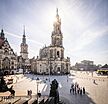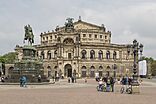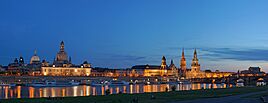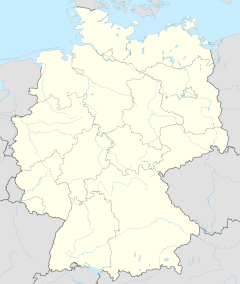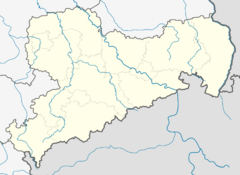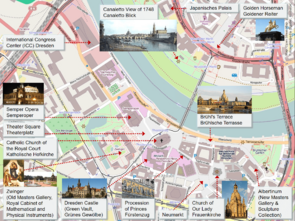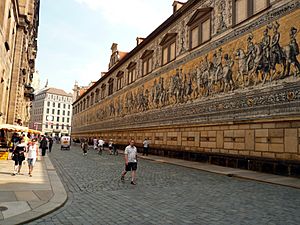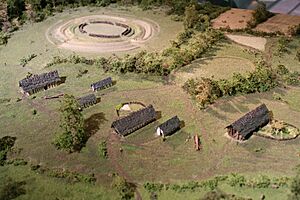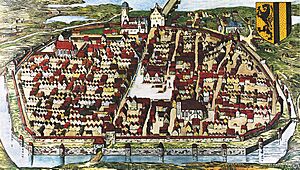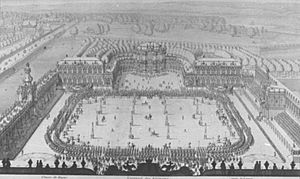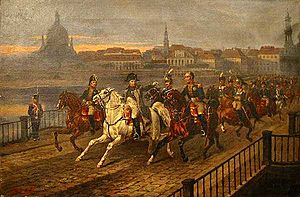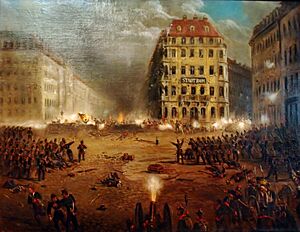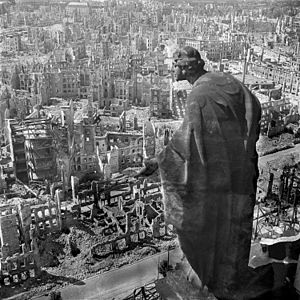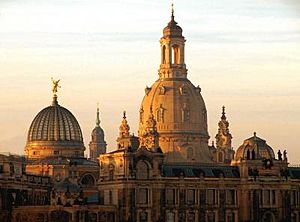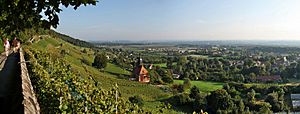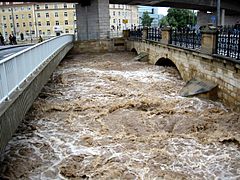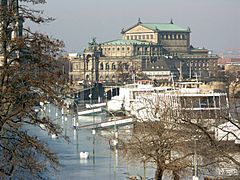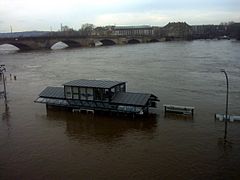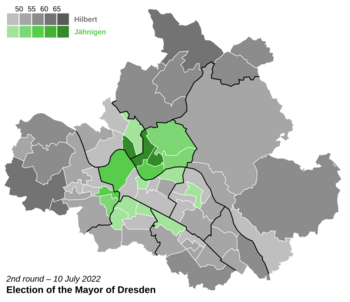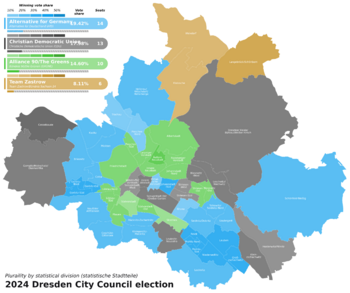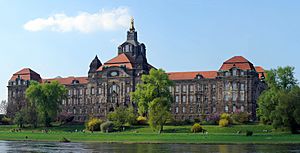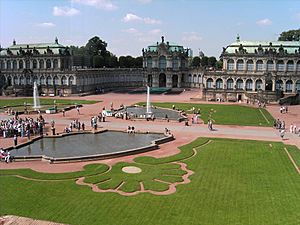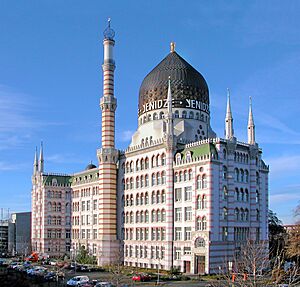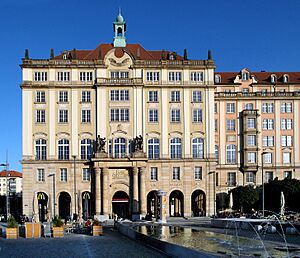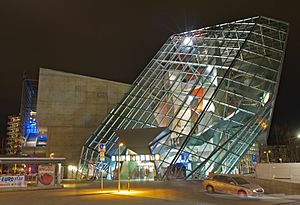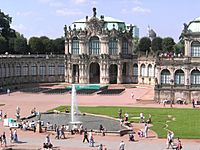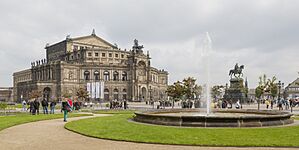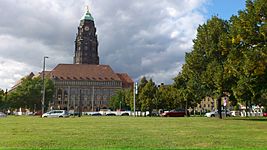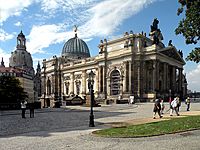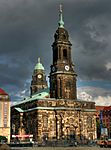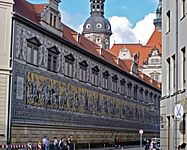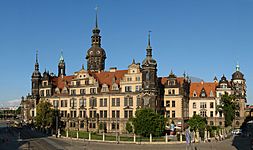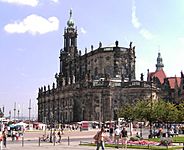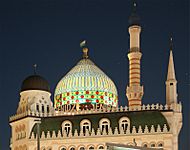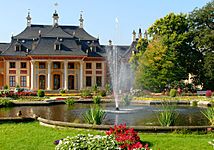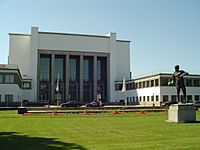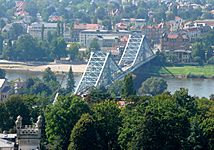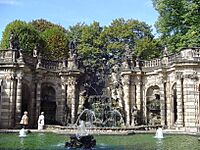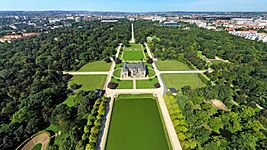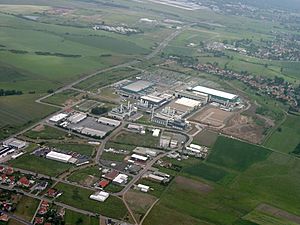Dresden facts for kids
Quick facts for kids
Dresden
|
|||
|---|---|---|---|
|
|
|||
|
|||
| Country | Germany | ||
| State | Saxony | ||
| District | Urban district | ||
| Area | |||
| • City | 328.8 km2 (127.0 sq mi) | ||
| Elevation | 113 m (371 ft) | ||
| Population
(2022-12-31)
|
|||
| • City | 563,311 | ||
| • Density | 1,713.23/km2 (4,437.3/sq mi) | ||
| • Urban | 790,400 | ||
| • Metro | 1,343,305 | ||
| Time zone | UTC+01:00 (CET) | ||
| • Summer (DST) | UTC+02:00 (CEST) | ||
| Vehicle registration | DD | ||
|
Former UNESCO World Heritage Site
|
|||
| Official name: Dresden Elbe Valley | |||
| Type: | Cultural | ||
| Criteria: | ii, iii, iv, v | ||
| Designated: | 2004 (28th session) | ||
| Reference #: | 1156 | ||
| Region: | Europe | ||
| Delisted: | 2009 (33rd session) | ||
Dresden is a major city in Germany and the capital of the state of Saxony. It's the second largest city in Saxony and the 12th largest in Germany by population. Dresden is also one of the biggest cities in Germany by area.
The city is located on the River Elbe, which is a very important river in Germany. Most people in Dresden live in the Elbe Valley. The city's name comes from a Sorbian word meaning "people of the forest."
Dresden has a long and interesting history. It was once the home of the kings of Saxony. They filled the city with beautiful art and buildings. Because of its amazing Baroque and Rococo architecture, it was known as the "Jewel Box." Sadly, much of the city center was destroyed during World War II. However, many historic buildings have been rebuilt.
Today, Dresden is a busy center for culture, education, and politics in Germany. It has one of the largest universities in the country, the Dresden University of Technology. The city's economy is strong, especially in high-tech industries. This area is even called "Silicon Saxony" because of all the tech companies.
Dresden is a popular place for tourists, with millions of visitors each year. Famous landmarks include the Frauenkirche church, the Zwinger palace, and the Semperoper opera house. The city also has amazing art collections and museums. One of the oldest and largest Christmas markets in Germany, the Striezelmarkt, is held here every year.
Contents
- Dresden's Past: A Look Back in Time
- Dresden's Location and Natural Beauty
- Dresden's People: A Growing City
- How Dresden is Governed
- Dresden's Sister Cities
- Dresden's Beautiful Buildings and Places
- Dresden's Culture and Entertainment
- Getting Around Dresden
- Dresden's Economy and Jobs
- Learning and Science in Dresden
- Sports in Dresden
- Quality of Life in Dresden
- Famous People from Dresden
- See also
Dresden's Past: A Look Back in Time
Historical affiliations
![]() Margravate of Meissen, 1319–1423
Margravate of Meissen, 1319–1423
![]() Electorate of Saxony, 1423–1806
Electorate of Saxony, 1423–1806
![]() Kingdom of Saxony, 1806–1848
Kingdom of Saxony, 1806–1848
![]() German Empire, 1848–1849
German Empire, 1848–1849
![]() Kingdom of Saxony, 1849–1918
Kingdom of Saxony, 1849–1918
![]() North German Confederation (Kingdom of Saxony), 1867–1871
North German Confederation (Kingdom of Saxony), 1867–1871
![]() German Empire (Kingdom of Saxony), 1867–1918
German Empire (Kingdom of Saxony), 1867–1918
![]() Weimar Republic (Free State of Saxony), 1918–1933
Weimar Republic (Free State of Saxony), 1918–1933
![]() Nazi Germany, 1933–1945
Nazi Germany, 1933–1945
![]() Soviet occupation zone of Germany, 1945–1949
Soviet occupation zone of Germany, 1945–1949
![]() East Germany, 1949–1990
East Germany, 1949–1990
![]() Germany (Free State of Saxony), 1990–present
Germany (Free State of Saxony), 1990–present
Dresden started as a Slavic village. People lived in this area as far back as 7500 BC. The city grew as German people moved eastward and mining began in the nearby Ore Mountains. Its name comes from the Sorbian word Drježdźany, meaning "people of the forest." Dresden later became the capital of Saxony.
How Dresden Began
Around the late 1100s, a Slavic settlement called Drežďany grew on the southern bank of the Elbe River. By 1206, Dresden was mentioned as a city. After 1270, Dresden became the capital of the region. It was ruled by the House of Wettin family from 1319. From 1485, it was the home of the dukes and later the electors of Saxony.
Dresden's Golden Age (17th-18th Centuries)
In 1697, Frederick Augustus I, the ruler of Saxony, also became King Augustus II the Strong of Poland. He brought many talented artists, musicians, and architects to Dresden. This made Dresden a leading city for art and technology in Europe. During his rule and that of his son, Augustus III of Poland, many of Dresden's beautiful Baroque buildings were constructed.
These buildings include the Zwinger Royal Palace, the Japanese Palace, and two important churches: the Catholic Hofkirche and the Lutheran Frauenkirche. Many famous art collections and museums were also started during this time.
Dresden faced tough times during the Seven Years' War (1756–1763). It was captured and attacked several times. Later, in 1785, Friedrich Schiller finished his famous poem Ode to Joy in Dresden.
Dresden in the 19th and Early 20th Centuries
In 1806, Dresden became the capital of the Kingdom of Saxony under Napoleon. Napoleon even used it as a base during his wars. After the Congress of Vienna in 1815, Saxony joined the German Confederation.
Many Polish people, including famous artists and leaders, moved to Dresden after uprisings in Poland. The writer Adam Mickiewicz wrote one of his greatest works, Dziady, Part III, there. Dresden itself saw some unrest during the German revolutions of 1848–49. By 1852, Dresden's population grew to 100,000 people.
When the German Empire was formed in 1871, Dresden became a major center for business. It was known for making cars, processing food, banking, and producing medical equipment. In the early 1900s, it was famous for cameras and cigarette factories. Dresden was a hub for modern art until 1933.
Military Presence in Dresden
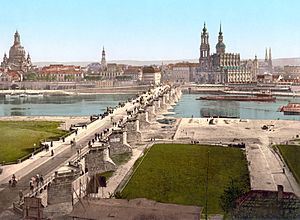
In 1871, a large military base called Albertstadt was built in Dresden. It could hold up to 20,000 soldiers. This base was used again before World War II.
Today, the former Albertstadt base is home to the Military History Museum of Germany.
Dresden During World War II
During the Nazi era (1933-1945), many Jewish people and others were persecuted in Dresden. The city's main synagogue was destroyed in 1938. Over 1,300 people were executed by the Nazis at Münchner Platz. Dresden also had forced labor camps where thousands of people were held.
Dresden was an important city for communication and manufacturing during World War II. It was also a strong military point for Germany. In the final months of the war, Dresden had about 600,000 refugees, making the total population around 1.2 million.
The Bombing of Dresden
The bombing of Dresden by British and American forces in February 1945 was very controversial. On the night of February 13-14, 1945, many bombs were dropped, destroying most of the city center. Between 22,500 and 25,000 people died, mostly civilians.
The Allies said the bombing was aimed at military and industrial targets. However, some people argue that the attacks were too extreme. Many refugees, mostly women and children, died because there weren't enough air raid shelters.
The American author Kurt Vonnegut wrote his famous novel Slaughterhouse Five based on his own experiences as a prisoner of war during the bombing. Every year, people in Dresden hold peace demonstrations to remember the victims of the bombing.
Dresden After the War

After World War II, a German photographer named Richard Peter took many pictures of the ruined city. His photo "View of Dresden from the Rathaus Tower" became very famous.
The damage was so bad that a special narrow-gauge railway was built to remove all the rubble. This railway had seven lines and employed 5,000 people. It ran until 1958.
In the 1950s and 1960s, the East German government decided to tear down the ruins of many churches and palaces instead of repairing them. However, most historic buildings were saved or rebuilt over many years. The ruins of the Frauenkirche were left as a memorial to the war for a long time.
Dresden became a major industrial center in East Germany. Many historic buildings like the Semper Opera House and the Zwinger Palace were rebuilt. But some areas were rebuilt in a "socialist modern" style.
After Germany reunited in 1990, Soviet troops left Dresden. From 1985 to 1990, Vladimir Putin, who later became President of Russia, worked for the KGB in Dresden. In 1989, people in Dresden joined protests against the communist government.
Dresden Today: After Reunification
Dresden has changed a lot since Germany reunited in the early 1990s. The city has been greatly rebuilt. The Dresden Frauenkirche was rebuilt between 1994 and 2005, with help from private donations. The gold cross on top of the church was even paid for by "the British people and the House of Windsor."
The area around the Neumarkt square, where the Frauenkirche stands, is still being rebuilt. Many new buildings are being constructed to look like the original historic ones.
In 2002, the River Elbe flooded, causing a lot of damage to the city. But the city was rebuilt quickly, and you can't see the damage anymore.
In 2004, UNESCO named the Dresden Elbe Valley a World Heritage Site. But in 2009, Dresden lost this title because a new bridge, the Waldschlößchenbrücke, was built across the Elbe. UNESCO said the bridge would harm the cultural landscape.
Dresden's Location and Natural Beauty
Where is Dresden Located?
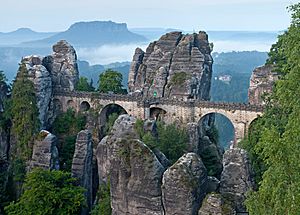
Dresden is located on both sides of the River Elbe. It sits in the Dresden Basin, with mountains to the south and east. The highest point in Dresden is Triebenberg, at 384 meters (1,260 feet) high.
Because of its beautiful location on the Elbe and its stunning Baroque buildings, Dresden is sometimes called "Elbflorenz" (Florence on the Elbe). Dresden is one of the largest cities in Germany by area.
Nearby German cities include Chemnitz (62 km southwest), Leipzig (100 km northwest), and Berlin (165 km north). Prague in the Czech Republic is about 150 km south, and Wrocław in Poland is 200 km east.
Nature in and Around Dresden
Dresden is known as one of the greenest cities in Europe. About 62% of the city is made up of green spaces and forests. The Dresden Heath is a large forest of 50 square kilometers (19 square miles) in the north. There are also four nature reserves and many protected gardens and parks.
The Elbe meadows, which stretch for 20 kilometers (12 miles) through the city, are an important part of Dresden's natural landscape. The beautiful Saxon Switzerland National Park is just southeast of the city.
Dresden's Climate
Dresden has a climate with warm summers and slightly colder winters than the average for Germany. The warmest month is July, with an average temperature of 19.0°C (66.2°F). January is the coldest, averaging 0.1°C (32.2°F). The driest months are February, March, and April. The wettest months are July and August.
| Climate data for Dresden(1971–2000 normals) | |||||||||||||
|---|---|---|---|---|---|---|---|---|---|---|---|---|---|
| Month | Jan | Feb | Mar | Apr | May | Jun | Jul | Aug | Sep | Oct | Nov | Dec | Year |
| Mean daily maximum °C (°F) | 2.7 (36.9) |
4.1 (39.4) |
8.4 (47.1) |
12.9 (55.2) |
18.7 (65.7) |
21.3 (70.3) |
23.6 (74.5) |
23.7 (74.7) |
18.8 (65.8) |
13.5 (56.3) |
6.9 (44.4) |
4.0 (39.2) |
13.2 (55.8) |
| Mean daily minimum °C (°F) | −2.2 (28.0) |
−1.8 (28.8) |
1.3 (34.3) |
3.9 (39.0) |
8.6 (47.5) |
11.8 (53.2) |
13.7 (56.7) |
13.6 (56.5) |
10.4 (50.7) |
6.4 (43.5) |
1.9 (35.4) |
−0.6 (30.9) |
5.6 (42.0) |
| Average precipitation mm (inches) | 44.3 (1.74) |
34.9 (1.37) |
43.1 (1.70) |
47.3 (1.86) |
60.0 (2.36) |
68.5 (2.70) |
82.0 (3.23) |
77.9 (3.07) |
49.6 (1.95) |
44.5 (1.75) |
53.5 (2.11) |
56.9 (2.24) |
662.5 (26.08) |
| Average precipitation days | 9.8 | 8.9 | 8.8 | 9.3 | 8.6 | 10.5 | 10.3 | 9.2 | 8.3 | 8.2 | 10.6 | 11.1 | 113.6 |
| Source: WMO | |||||||||||||
| Climate data for Dresden (1991–2020 normals, extremes 1934–present) | |||||||||||||
|---|---|---|---|---|---|---|---|---|---|---|---|---|---|
| Month | Jan | Feb | Mar | Apr | May | Jun | Jul | Aug | Sep | Oct | Nov | Dec | Year |
| Record high °C (°F) | 16.8 (62.2) |
20.0 (68.0) |
24.4 (75.9) |
29.5 (85.1) |
31.7 (89.1) |
38.2 (100.8) |
36.4 (97.5) |
37.4 (99.3) |
33.9 (93.0) |
27.8 (82.0) |
19.5 (67.1) |
17.7 (63.9) |
38.2 (100.8) |
| Mean daily maximum °C (°F) | 3.0 (37.4) |
4.5 (40.1) |
8.5 (47.3) |
14.3 (57.7) |
18.8 (65.8) |
22.2 (72.0) |
24.5 (76.1) |
24.2 (75.6) |
19.1 (66.4) |
13.5 (56.3) |
7.6 (45.7) |
4.1 (39.4) |
13.7 (56.7) |
| Daily mean °C (°F) | 0.6 (33.1) |
1.5 (34.7) |
4.7 (40.5) |
9.7 (49.5) |
14.0 (57.2) |
17.3 (63.1) |
19.4 (66.9) |
19.1 (66.4) |
14.6 (58.3) |
9.8 (49.6) |
5.0 (41.0) |
1.7 (35.1) |
9.8 (49.6) |
| Mean daily minimum °C (°F) | −2.0 (28.4) |
−1.5 (29.3) |
1.1 (34.0) |
4.8 (40.6) |
8.9 (48.0) |
12.3 (54.1) |
14.3 (57.7) |
14.1 (57.4) |
10.4 (50.7) |
6.5 (43.7) |
2.4 (36.3) |
−0.7 (30.7) |
5.9 (42.6) |
| Record low °C (°F) | −25.3 (−13.5) |
−23.0 (−9.4) |
−16.5 (2.3) |
−6.3 (20.7) |
−3.4 (25.9) |
0.9 (33.6) |
6.1 (43.0) |
5.4 (41.7) |
0.0 (32.0) |
−6.0 (21.2) |
−13.2 (8.2) |
−21.0 (−5.8) |
−25.3 (−13.5) |
| Average precipitation mm (inches) | 42.1 (1.66) |
32.7 (1.29) |
42.1 (1.66) |
36.3 (1.43) |
62.9 (2.48) |
62.6 (2.46) |
84.5 (3.33) |
80.1 (3.15) |
51.7 (2.04) |
49.9 (1.96) |
47.5 (1.87) |
44.0 (1.73) |
636.4 (25.06) |
| Average precipitation days (≥ 0.1 mm) | 17.4 | 14.4 | 15.1 | 11.4 | 13.7 | 13.5 | 14.6 | 12.7 | 11.9 | 14.0 | 14.7 | 16.1 | 169.4 |
| Average snowy days (≥ 1.0 cm) | 12.1 | 9.8 | 4.5 | 0.6 | 0 | 0 | 0 | — | 0 | 0.1 | 2.2 | 6.4 | 35.7 |
| Average relative humidity (%) | 82.6 | 78.7 | 74.4 | 67.0 | 67.9 | 68.5 | 67.1 | 67.8 | 74.9 | 79.8 | 84.3 | 83.7 | 74.7 |
| Mean monthly sunshine hours | 62.0 | 82.1 | 127.0 | 187.3 | 222.0 | 221.3 | 233.8 | 222.8 | 164.2 | 119.9 | 67.9 | 60.0 | 1,770.4 |
| Source 1: NOAA | |||||||||||||
| Source 2: Data derived from Deutscher Wetterdienst(precipitation(Klotzsche) | |||||||||||||
Protecting Dresden from Floods
Because Dresden is on the Elbe River, protecting it from floods is very important. Large areas are kept clear of buildings to act as a flood plain. Special trenches have also been built to help move water away from the city center.
In 2002, a huge flood hit Dresden. The Weißeritz River, usually small, flowed right into the main train station. This happened because the river returned to an old path it used to take. Many parts of the city need walls and barriers to protect them during floods.
-
Semperoper during 2005 floods
How Dresden is Organized
Dresden is a large city with different kinds of neighborhoods. Some parts still have old village centers, while others are very rural. There are also historic areas that grew outside the old city walls. During the time of East Germany, many apartment blocks were built. The oldest parts of the city are called Altstadt (Old town) and Neustadt (New town).
Dresden is divided into ten main areas called "Stadtbezirk" and nine smaller areas that joined the city after 1990.
Dresden's People: A Growing City
| Historical population | ||
|---|---|---|
| Year | Pop. | ±% |
| 1501 | 2,500 | — |
| 1603 | 14,793 | +491.7% |
| 1699 | 21,298 | +44.0% |
| 1727 | 46,472 | +118.2% |
| 1755 | 63,209 | +36.0% |
| 1772 | 44,760 | −29.2% |
| 1800 | 61,794 | +38.1% |
| 1813 | 51,175 | −17.2% |
| 1830 | 61,886 | +20.9% |
| 1840 | 82,014 | +32.5% |
| 1852 | 104,199 | +27.1% |
| 1861 | 128,152 | +23.0% |
| 1871 | 177,089 | +38.2% |
| 1880 | 220,818 | +24.7% |
| 1890 | 276,522 | +25.2% |
| 1900 | 396,146 | +43.3% |
| 1905 | 516,996 | +30.5% |
| 1910 | 548,308 | +6.1% |
| 1916 | 528,732 | −3.6% |
| 1920 | 540,900 | +2.3% |
| 1925 | 619,157 | +14.5% |
| 1930 | 633,441 | +2.3% |
| 1933 | 649,252 | +2.5% |
| 1935 | 637,052 | −1.9% |
| 1940 | 626,900 | −1.6% |
| 1944 | 566,738 | −9.6% |
| 1945 | 368,519 | −35.0% |
| 1946 | 467,966 | +27.0% |
| 1950 | 494,187 | +5.6% |
| 1955 | 496,548 | +0.5% |
| 1960 | 493,603 | −0.6% |
| 1965 | 508,119 | +2.9% |
| 1970 | 502,432 | −1.1% |
| 1975 | 509,331 | +1.4% |
| 1980 | 516,225 | +1.4% |
| 1985 | 519,769 | +0.7% |
| 1990 | 490,571 | −5.6% |
| 1995 | 469,110 | −4.4% |
| 2001 | 478,631 | +2.0% |
| 2011 | 512,354 | +7.0% |
| 2022 | 557,782 | +8.9% |
| Source: Source for 2001–2022: |
||
| Nationality | Population (31 December 2022) |
|---|---|
| 8,961 | |
| 2,395 | |
| 2,342 | |
| 2,230 | |
| 1,943 | |
| 1,739 | |
| 1,549 | |
| 1,276 | |
| 1,126 | |
| 1,078 |
Dresden's population reached 100,000 people in 1852. It was one of the first German cities to do so. The population was highest in 1933, with almost 650,000 people. After World War II, it dropped to about 368,000 because of the destruction.
Since Germany reunited, Dresden's population has changed a lot. It grew quickly between 2000 and 2010. Dresden is now one of the fastest-growing cities in Germany.
As of 2019, Dresden had over 557,000 people. The larger Dresden area has about 790,000 people. The wider metropolitan area, including nearby districts, has about 1.34 million people.
In 2018, about half of Dresden's population was female. The average age in Dresden is 43 years, which is quite young for a city in Saxony. About 12% of the population has a background from other countries.
How Dresden is Governed
Dresden is one of Germany's 16 political centers and the capital of Saxony. It has its own local government that makes decisions for the city.
Dresden has hosted important international meetings, like talks between Russia and Germany.
The Mayor of Dresden
The city council is like the city's parliament. It gives instructions to the mayor through its decisions. The mayor is the head of the city government.
The first mayor elected after Germany reunited was Herbert Wagner. Since 1994, the mayor has been chosen directly by the people of Dresden. The current mayor is Dirk Hilbert, who was elected in 2015. The most recent mayoral election was in 2022.
| Candidate | Party | First round | Second round | |||
|---|---|---|---|---|---|---|
| Votes | % | Votes | % | |||
| Dirk Hilbert | Independent Citizens for Dresden (FDP, FW, CDU) |
66,165 | 32.5 | 80,483 | 45.3 | |
| Eva Jähnigen | Alliance 90/The Greens (plus SPD, Left, Pirates in the runoff) |
38,473 | 18.9 | 67,947 | 38.3 | |
| Albrecht Pallas | Social Democratic Party | 31,068 | 15.2 | Withdrew | ||
| Maximilian Krah | Alternative for Germany | 28,971 | 14.2 | 21,741 | 12.2 | |
| André Schollbach | The Left | 20,898 | 10.3 | Withdrew | ||
| Marcus Fuchs | Independent | 6,856 | 3.4 | 3,549 | 2.0 | |
| Martin Schulte-Wissermann | Pirate Party | 5,975 | 2.9 | Withdrew | ||
| Sascha Wolff | Independent | 2,695 | 1.3 | Withdrew | ||
| Jan Pöhnisch | Die PARTEI | 2,684 | 1.3 | 3,824 | 2.2 | |
| Valid votes | 203,785 | 99.4 | 177,544 | 99.5 | ||
| Invalid votes | 1,145 | 0.6 | 974 | 0.5 | ||
| Total | 204,930 | 100.0 | 178,518 | 100.0 | ||
| Electorate/voter turnout | 432,294 | 47.4 | 431,967 | 41.3 | ||
| Source: City of Dresden (1st round, 2nd round) | ||||||
Dresden's City Council
The city council is elected by the people. The most recent election was in June 2024.
| Party | Votes | % | +/- | Seats | +/- | |
|---|---|---|---|---|---|---|
| Alternative for Germany (AfD) | 170,346 | 19.4 | 14 | |||
| Christian Democratic Union (CDU) | 157,717 | 18.0 | 13 | |||
| Alliance 90/The Greens (Grüne) | 128,099 | 14.6 | 10 | |||
| Social Democratic Party (SPD) | 78,652 | 9.0 | 6 | |||
| Team Zastrow/Alliance Saxony 24 | 71,163 | 8.1 | New | 6 | New | |
| The Left (Die Linke) | 68,012 | 7.8 | 5 | |||
| Sahra Wagenknecht Alliance (BSW) | 63,108 | 7.2 | New | 5 | New | |
| Free Voters Dresden (WV) | 31,110 | 3.5 | 2 | |||
| Pirate Party Germany (Piraten) | 27,736 | 3.2 | 2 | |||
| Free Democratic Party (FDP) | 24,464 | 2.8 | 2 | |||
| Die PARTEI (PARTEI) | 16,363 | 1.9 | 1 | |||
| Free Saxons (FS) | 13,304 | 1.5 | New | 1 | New | |
| Volt Germany (Volt) | 10,522 | 1.2 | New | 1 | New | |
| Dissidents Dresden (DissDD) | 8,365 | 1.0 | New | 1 | New | |
| Free Citizens Dresden (FBD) | 8,290 | 0.9 | 1 | |||
| Valid votes | 877,251 | 96.3 | ||||
| Invalid votes | 3,802 | 1.3 | ||||
| Total | 303,717 | 100.0 | 70 | ±0 | ||
| Electorate/voter turnout | 429,280 | 70.8 | ||||
| Source: Wahlen in Sachsen | ||||||
Public Offices in Dresden
As the capital of Saxony, Dresden is home to the state parliament and government ministries. Many state offices are located here. Dresden also has local courts and federal agencies.
Dresden is a traditional place for training army officers in Germany.
Local Issues in Dresden
Local discussions in Dresden often focus on how the city is planned and developed. The design of buildings and public spaces can be a big topic. For example, building the Waldschlösschenbrücke bridge across the Elbe caused international debate.
In 2006, Dresden sold its public housing company. This made Dresden the first large German city to be debt-free.
Dresden has seen protests from some groups. In 2014, a group called Pegida started weekly demonstrations. In 2019, the Dresden City Council passed a statement against groups that are against democracy and human rights.
Dresden's Sister Cities
Dresden has special connections with other cities around the world. These are called "twin towns" or "sister cities." For example, Dresden and Coventry, England, became sister cities after World War II. Both cities had suffered from heavy bombings. This was a way to show friendship and healing.
Dresden is twinned with:
- Coventry, England, United Kingdom (1959)
- Saint Petersburg, Russia (1961, suspended)
- Wrocław, Poland (1963)
- Skopje, North Macedonia (1967)
- Ostrava, Czech Republic (1971)
- Brazzaville, Congo (1975)
- Florence, Italy (1978)
- Hamburg, Germany (1987)
- Rotterdam, Netherlands (1988)
- Strasbourg, France (1990)
- Salzburg, Austria (1991)
- Columbus, United States (1992)
- Rouen, France (1994)
- Hangzhou, China (2009)
Friendly Cities
Dresden also has friendly relations with:
Dresden's Beautiful Buildings and Places

Dresden is famous for its architecture. While many buildings are Baroque, you can also see Renaissance and Historicism styles. Modern buildings are also part of the city's look. Dresden has about 13,000 cultural monuments.
Royal Buildings
The Dresden Castle was the home of the royal family from 1485. It has been rebuilt and changed many times, so it shows a mix of styles like Renaissance, Baroque, and Classicist.
The Zwinger Palace is near the castle. It was built for royal art collections and festivals. Its gate has a golden crown on top.
Other royal places include:
- Brühl's Terrace: A beautiful area with buildings overlooking the Elbe River.
- Dresden Elbe Valley: Home to Pillnitz Castle and other castles.
Churches and Sacred Places
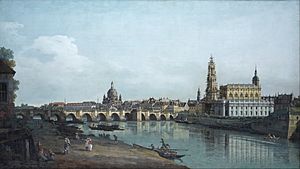
The Hofkirche was the church for the royal family. Augustus II the Strong had it built when he became Catholic to be King of Poland. It is now the Catholic cathedral. Many members of the royal family are buried there.
The Lutheran Frauenkirche at the Neumarkt was built by the people of Dresden around the same time. The historic Kreuzkirche was also a very old church, first used in 1388.
You can also find other churches in Dresden, like the Russian Orthodox St. Simeon of the Wonderful Mountain Church.
Historicist Architecture
Buildings in the Historicist style were popular in Dresden until the 1920s.
Examples include the Albertinum on Brühl's Terrace and the Saxon State Chancellery. The Yenidze is a former cigarette factory that looks like a mosque.
Some of the most recent historicist buildings in Dresden were built in the 1950s, like those at the Altmarkt.
Modern Architecture
The Garden City of Hellerau was founded in 1909 as Germany's first garden city. It became a center for modernism in Europe.
The German Hygiene Museum (built 1928–1930) is a good example of modern architecture from between the World Wars. It has a grand style but simple designs.
Important modern buildings built after World War II include the Centrum-Warenhaus (a large department store) and the Kulturpalast (a multi-purpose hall).
Newer Buildings
After Germany reunited in 1990, new styles of architecture appeared. Some important modern buildings are the New Synagogue, the Transparent Factory, and the UFA-Kristallpalast cinema.
Famous architects like Daniel Libeskind and Norman Foster have also worked on buildings in Dresden. Foster put a see-through roof over the main railway station. Libeskind added a wedge-shaped part to the Bundeswehr Military History Museum.
Bridges in Dresden
Important bridges crossing the Elbe River include the Blaues Wunder (Blue Wonder) bridge and the Augustus Bridge.
Statues and Monuments
You can see a golden equestrian statue of Augustus the Strong, called the Goldener Reiter (Golden Cavalier), in Neustädter Markt square. It shows Augustus riding towards Warsaw, where he was also King of Poland. There is also a statue of Martin Luther in front of the Frauenkirche.
Parks and Gardens
Großer Garten is a large Baroque garden in central Dresden. It has the Dresden Zoo and the Dresden Botanical Garden.
The Dresden Heath is a big forest in the northeast of Dresden. It's a great place for outdoor activities.
The park at Pillnitz Palace is known for its special plants, including a very old Japanese camellia.
Main Sights to See
Dresden's Culture and Entertainment

Many famous artists have worked in Dresden, including composers like Carl Maria von Weber and Richard Wagner. Dresden is home to many art collections and music groups.
Fun Things to Do
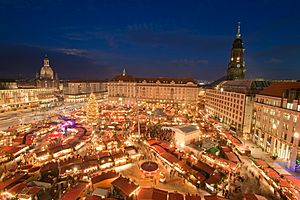
The Saxon State Opera comes from the opera company of the old kings of Saxony. The Semperoper opera house was destroyed in World War II but was rebuilt and reopened in 1985. Its orchestra, the Sächsische Staatskapelle Dresden, was founded in 1548.
Dresden has several choirs, including the famous Dresdner Kreuzchor, a boys' choir that started in the 13th century. The Dresden Philharmonic Orchestra is the city's main orchestra.
In the summer, you can enjoy outdoor concerts at the Zwingerhof. Dresden also has cinemas that show different kinds of movies.
The Striezelmarkt is one of Germany's largest and oldest Christmas markets. It started in 1434.
Every June, the city celebrates the Bunte Republik Neustadt, a three-day culture festival with free concerts and food in the streets.
Museums to Explore

Dresden has amazing art collections called the Staatliche Kunstsammlungen Dresden (Dresden State Art Collections). These include twelve museums, such as the Gemäldegalerie Alte Meister (Old Masters Gallery) and the Grünes Gewölbe (Green Vault).
Other interesting museums are:
- The Deutsche Hygiene-Museum, which teaches about health and the human body.
- The Landesmuseum für Vorgeschichte (State Museum of Prehistory).
- The Senckenberg Naturhistorische Sammlungen Dresden (Natural History Collections).
- The Verkehrsmuseum Dresden (Transport Museum).
- The Festung Dresden (Dresden Fortress).
- The Panometer Dresden (Dresden Panometer) (Panorama museum).
The Dresden City Museum tells the story of the city. The Bundeswehr Military History Museum is located in the old military base. The book museum of the Saxon State Library has the famous Dresden Codex. The Kraszewski Museum is dedicated to the Polish writer Józef Ignacy Kraszewski.
Getting Around Dresden
Buses in Dresden
The DVB company runs the public transport in Dresden. They have a "Good Night Line" bus service that runs late at night, especially on weekends. Postplatz is a main hub for these night buses.
Roads and Highways
Major highways cross Dresden, connecting it to other German cities like Berlin and to Prague in the Czech Republic. Several federal highways also run through the city.
Trains in Dresden
Dresden has two main train stations: Dresden Hauptbahnhof and Dresden-Neustadt railway station. Train lines connect Dresden to Berlin, Prague, Leipzig, and Chemnitz. There's also a local commuter train system called the Dresden S-Bahn.
Dresden Airport
Dresden Airport is the city's international airport. It's located on the northwestern edge of the city. The airport has been improved a lot since Germany reunited, with a new terminal and an underground train station.
Trams in Dresden
Dresden has a large tramway network with twelve lines. Many of the newer trams are very long. Some tram tracks run on grass to reduce noise, while others are on the streets.
The CarGoTram was a special tram that delivered parts to Volkswagen's Transparent Factory in the city center.
The districts of Loschwitz and Weisser Hirsch are connected by the Dresden Funicular Railway, which has been operating since 1895.
Dresden's Economy and Jobs

Before the communist era, Dresden was a very important German city. After Germany reunited in 1990, Dresden faced economic challenges. But with help from the German government, its economy has grown quickly.
Dresden is now one of the fastest-growing regions in Germany. The unemployment rate has dropped a lot. In 2017, Dresden had the highest economic output per person in Saxony.
Dresden is known for having many highly skilled workers. This is because of its public offices, research centers, and high-tech industries.
Main Industries in Dresden
Three main types of businesses are important in Dresden:
- Silicon Saxony: This is Dresden's semiconductor industry, which started in 1969. Big companies like GlobalFoundries and Infineon Technologies make computer chips here. Many other companies that supply materials for chip-making are also in Dresden.
- Pharmaceuticals: The medicine industry has been in Dresden since the late 1800s. The 'Sächsisches Serumwerk Dresden' (Saxon Serum Plant), owned by GlaxoSmithKline, is a world leader in making vaccines.
- Mechanical and Electrical Engineering: This is another traditional industry. Major employers include the Volkswagen Transparent Factory, Elbe Flugzeugwerke (Elbe Aircraft Works), and Siemens. Tourism also brings a lot of money and jobs to Dresden.
Media in Dresden
Dresden has two main newspapers: the Sächsische Zeitung and the Dresdner Neueste Nachrichten. There is also a broadcasting center for the Mitteldeutscher Rundfunk.
Learning and Science in Dresden
Dresden has many well-known universities and research centers.
Universities in Dresden
- The Dresden University of Technology (TU Dresden) is one of the oldest and largest technical universities in Germany. It has over 36,000 students and offers many different courses, not just technical ones.
- The Dresden University of Applied Sciences (Hochschule für Technik und Wirtschaft Dresden) was founded in 1992.
- The Dresden Academy of Fine Arts (Hochschule für Bildende Künste Dresden) started in 1764. Famous artists like Otto Dix and Gerhard Richter taught there.
- The Palucca School of Dance (Palucca Hochschule für Tanz) is a major European school for dance.
- The Carl Maria von Weber College of Music was founded in 1856.
There are also other universities for church music and social work.
Research Centers
Dresden has many important research institutes, some of which are known worldwide. They focus on areas like micro- and nanoelectronics, transport systems, materials, and bio-engineering.
- The Helmholtz-Zentrum Dresden-Rossendorf is a large research complex focusing on nuclear medicine and physics.
- The Max Planck Society has three institutes in Dresden that do basic research in areas like molecular cell biology and physics.
- The Fraunhofer Society has eleven institutes in Dresden. They do applied research for businesses.
- The Leibniz Community has three institutes in Dresden, focusing on materials research and urban planning.
High Schools in Dresden
Dresden has over 20 high schools that prepare students for university. Some of these are private schools. There are also schools that combine job training with high school education.
Sports in Dresden
Dresden is home to Dynamo Dresden, a famous football club that won many titles in East Germany. They now play in the 3. Liga.
In the early 1900s, Dresdner SC was one of Germany's most successful football clubs. They also have a women's volleyball team that plays in the top league.
Other sports teams include:
- ESC Dresdner Eislöwen: an ice hockey club.
- Dresden Monarchs: an American football team.
- Dresden Titans: the city's top basketball team.
Horse races have been held in Dresden since 1890. Major sports venues include the Rudolf-Harbig-Stadion and the EnergieVerbund Arena.
Quality of Life in Dresden
Dresden is considered one of the least stressful cities in the world. In a 2017 ranking, it was placed 15th out of 150 cities worldwide.
Famous People from Dresden
Public Service
- Augustus II the Strong (1670–1733), Elector of Saxony and King of Poland.
- Augustus III of Poland (1696–1763), Elector of Saxony and King of Poland.
- Frederick Augustus I of Saxony (1750–1827), King of Saxony.
- Frederick Augustus II of Saxony (1797–1854), King of Saxony.
- John, King of Saxony (1801–1873), King of Saxony.
- Albert, King of Saxony (1828–1902), King of Saxony.
- George, King of Saxony (1832–1904), King of Saxony.
- Frederick Augustus III of Saxony (1865–1932), King of Saxony.
- Max Immelmann (1890–1916), WWI fighter pilot.
- Herbert Wehner (1906–1990), politician.
- Katja Kipping (born 1978), politician.
Arts and Culture
- Ludwig Richter (1803–1884), painter.
- Hans von Bülow (1830–1894), conductor and pianist.
- Victor Klemperer (1881–1960), author.
- Erich Kästner (1899–1974), author of children's books.
- Gerhard Richter (born 1932), painter.
- Thomas Fritsch (1944–2021), actor.
Science and Business
- Ehrenfried Walther von Tschirnhaus (1651–1708), mathematician and physicist.
- Ferdinand A. Lange (1815–1875), watchmaker, founder of A. Lange & Söhne.
- Ernst Engel (1821–1896), statistician and economist.
Sports
- Matthias Sammer (born 1967), footballer and coach.
- Helmut Schön (1915–1996), football coach.
- Fritz Wiessner (1900–1988), pioneer of free climbing.
- Axel Tischer (born 1986), professional wrestler.
|
See also
 In Spanish: Dresde para niños
In Spanish: Dresde para niños




